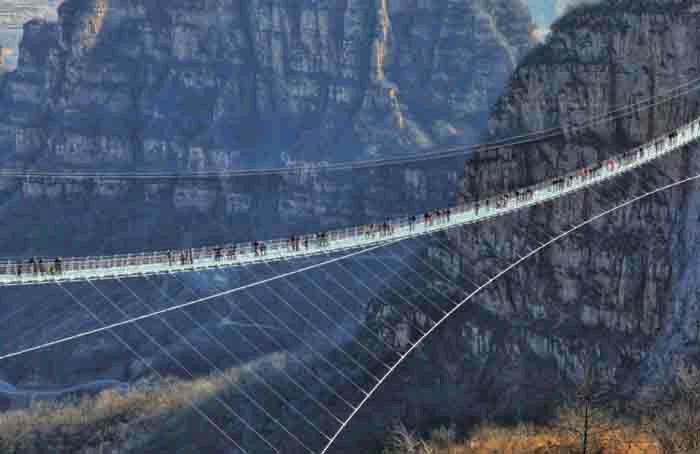Glass Bridge
2018-01-09
Tourists walk on a glass suspension bridge at the Hongyagu scenic spot in Pingshan County, north Chinas Hebei Province, on December 24, 2017. The 488-meter-long glass suspension bridge was formally opened to the public on that day.
Pollution Punishment
China addressed more environmental pollution cases in the fi rst 11 months of 2017, according to the Ministry of Environmental Protection(MEP).
From January to November last year, China investigated over 35,600 violations of environmental protection laws and regulations, up more than 102 percent year on year, according to Tian Weiyong, an offi cial with the MEP.
Fines totaling over 1 billion yuan($153 million) were handed out in 1,046 cases where violators must pay daily fi nes until they address their wrongdoings, up more than 43 percent and 31 percent year on year, respectively.
Meanwhile, more than 2,500 cases were transferred to public security departments, rising by over 46 percent year on year.
Environmental authorities have ordered production suspension or production cuts in more than 7,800 cases during the same period, according to Tian.
China held more than 6,400 offi cials in eight provincial-level regions accountable for environmental damage after inspections by central authorities from August to September 2017.
The inspections are part of Chinas campaign to fi ght pollution and environmental damage. Tackling pollution has been listed as one of “the three tough battles”that China aims to win in the next three years, according to the Central Economic Work Conference that concluded on December 20, 2017.
Permanent Residence
China has issued 4,819 new version permanent residence identity cards to foreigners since the project was launched in June 2017, the Ministry of Public Security said on December 26, 2017.
Compared with the old cards, the new cards are embedded with chips and can be read by machines, according to the ministrys exit-entry administration bureau.
The new cards are a result of reforms aimed at making the cards recognizable by machines and widely known and accepted in various parts of society, including railways, civil aviation, insurance, hotels, and banks. According to the ministry, the benefi ts enjoyed by foreigners holding permanent residence cards will be announced later.
Renovating Homes
China will renovate 5.8 million dilapidated homes in 2018 to speed up urbanization.endprint
The country started renovation of 6.1 million homes in 2017, more than the target of 6 million, according to Wang Menghui, Minister of Housing and Urban-Rural Development.
Total investment reached 1.84 trillion yuan ($280 billion) in 2017, he said.
Authorities should increase the supply of public rental housing and offer it to poor families and groups including sanitation workers, young teachers and migrant workers.
China plans to renovate 15 million homes from 2018 to 2020, according to an offi cial document.
The plan is part of efforts to fulfi ll the governments promise to rebuild rundown areas with a combined total of 100 million residents. The transformation has remained a priority for the government in recent years. In the past eight years, more than 80 million people with poor living conditions moved out of rundown areas and into new homes.
Colorectal Cancer
Chinese doctors said the incidence of colorectal cancer has been rising among young white-collar workers due to unhealthy lifestyles and eating habits.
Colorectal cancer usually occurs in people around 60 in developed countries, but in China, the average age at which people contract the disease is 45, said Professor Kong Dalu from Tianjin Cancer Hospital.
“The number of white-collar[workers] under 30 diagnosed with colon cancer has been rising steadily in recent years, accounting for 10 percent of all inpatients with the disease,” he said.
The disturbing rise is in part due to their sedentary lifestyle and unhealthy diet, said Kong.
China has seen rapid improvements in living standards in recent decades, resulting in diets rich in fat, calories and protein, but low in fi ber.
Oncologists recommend that young adults engage in regular physical activity and stick to a diet rich in whole grains, vegetables and fruit and low in red and processed meats to prevent the disease.
“Colorectal cancer can be cured, and patients have a better chance of survival if the disease is detected at an earlier stage,” he said.
Doctors recommend screening tests every fi ve years for people over 50.
Illegal Websites
China has shut down or revoked the licenses of more than 13,000 illegal websites since 2015.
Wang Shengjun, Vice Chairman of the Standing Committee of the National Peoples Congress (NPC), disclosed the information when briefi ng lawmakers on cyberspace protection on December 24, 2017.endprint
Authorities including the Cyberspace Administration of China have contacted over 2,200 website operators for talks during the same period, he said.
In addition, operators have closed nearly 10 million Internet accounts for violating service protocols, while information on terrorism and pornography has been removed.
“These moves have a powerful deterrent effect,” Wang said.
The report was submitted for deliberation by the top legislature at the session of its regular bi-monthly meeting which ended on December 27 last year.
Expanding Grassland
The grassland coverage in Tibet Autonomous Region has been increasing, said the regional agricultural department.
The natural grassland coverage rate in 2017 was around 45.2 percent, up 2.5 percentage points from the fi gure in 2010, the regional agricultural and herding department said.
Herding has been banned on 8.6 million hectares of grassland in Tibet, about 10 percent of the total area of natural grassland in the region. The ban was introduced to tackle degradation and retreat of grassland.
In 2016, a total of 3.2 billion yuan ($480 million) was used to pay local herders to protect the grassland and limit herding. In 2017, the Central Government allocated 3.26 billion yuan ($497 million) to compensate the herders.
The number of cattle is limited to 18 million, down from 23 million in 2010, said Xiao Changwei, Deputy Director of the department.
Circuit Court
The fourth circuit court of Chinas Supreme Peoples Court (SPC) has closed 2,304 cases since its founding in December 2016, the SPC said on December 25, 2017.
The circuit court accepted 2,880 cases, received 26,219 visits, answered 1,679 letters from the public, and put 1,441 judgment documents online, according to the SPC.
The court paid attention to both judgment and mediation in hearing cases and settled 18 civil cases through mediation, said the SPC.
The court also forbids judges from hearing cases in their home- towns in order to keep sentences fair, said the SPC.
Circuit courts are adjudicatory organs designated by the SPC, and their judgments, orders and decisions equal those of the SPC. Circuit courts mainly handle major administrative, civil and commercial cases which should be heard by the SPC.
The first circuit court was inaugurated in 2015 in Shenzhen, south Chinas Guangdong Province. The fourth circuit court covers four provinces: Henan, Shanxi, Hubei and Anhui.endprint
Winter Celebration
Women of the Oroqen ethnic group dance during an ice and snow festival in Hulun Buir, north Chinas Inner Mongolia Autonomous Region, on December 26, 2017.
Little Handicraftsmen
Contestants pose for a photo with their work during a handicraft contest for children and teenagers in Liuzhou, south Chinas Guangxi Zhuang Autonomous Region, on December 24, 2017.
Logistics Costs Reduced
According to the Ministry of Transport, China reduced logistics costs by more than 88 billion yuan($13.4 billion) in 2017.
The reductions were achieved through such measures as the removal of certain tolls on the roads of provincial-level regions, as well as streamlined traffi c services, the ministry said.
Li Xiaopeng, Minister of Transport, said that China will continue to drive supply-side structural reform in the transport industry, and further lower logistics costs in 2018.
The country will seek to expand pilot schemes for highway toll collection, while streamlining charges in ports, Li said.
Statistics from the National Development and Reform Commission (NDRC) showed that the cost of logistics in China constituted around 14.9 percent of GDP in 2016, down by 1.1 percentage points on the previous year.
Although this ratio had dropped for four consecutive years by 2016, it is still markedly higher than other developing economies.
Authorities stepped up reform efforts in the transport sector in 2017 to reduce the logistics burden of companies. Rail freight charges have been either canceled or lowered, while additional means of fi nancing have been made available to companies in the logistics sector.
Thriving Highways
The 52-km Wanzhou-Lichuan Highway, linking Wanzhou in southwest Chinas Chongqing Municipality with Lichuan in central Chinas Hubei Province, is put into use on December 26, 2017, following a total investment of 8.13 billion yuan($1.24 billion).
Rising Cyber Power
In the coming years China will seek to advance the development of information technology and the spread of Internet applications, with the aim of becoming a world- leading cyber power by 2035, a senior offi cial said on December 25, 2017.
“China will endeavor to build itself into a strong cyber power by 2035, ranking among the worlds elite group in cyberspace,” said Miao Wei, Minister of Industry and Information Technology, at a work conference.endprint
In order to reach this target, China will launch a series of strategic projects, seek breakthroughs in key technologies and accelerate the upgrading of the Internet, he said.
Deeper integration between the Internet, big data, artifi cial intelligence (AI) and manufacturing will be encouraged, and guidelines for stimulating the digital economy will be introduced, according to Miao.
He also promised to strengthen regulation in order to better protect private information and online data.
A booming digital economy is reshaping Chinas economic landscape as the spread of technology such as big data and AI revives traditional industries.
As of June 2017, there were 3.89 billion Internet users around the world, of which 751 million were in China. This huge number of Web users has created room for risk-takers in e-commerce, mobile payments and other emerging areas to take their chances.
Fruit Futures Launched
On the morning of December 22, 2017, the worlds fi rst apple futures contracts started trading on the Zhengzhou Commodity Exchange in central Chinas Henan Province.
China is already the worlds largest apple grower and consumer. Its apple output has been increasing over the past decade. In 2016, China had 2 million hectares of apple trees with an output of 43.88 million tonnes, accounting for 57 percent of global supply.
Apple growing is a feature of Chinas poverty alleviation campaign, as many of Chinas impoverished areas rely on apples as a major source of income. Among the 122 main apple-growing cities and counties listed by the Ministry of Agriculture, 33 are considered national-level impoverished counties.
At the moment apple prices are determined solely by the market, meaning that farmers and enterprises are at the mercy of market price fl uctuations.
The launch of the futures is expected to make prices more transparent, and help growers hedge against market risks.
Green Development Index
China released its fi rst green development index on December 26, 2017, which ranks local government performances on ecological devel-opment and helps to promote highquality development.
In the green development index ranking for 2016, Beijing, along with the provinces of Fujian and Zhejiang, were the three highest-ranking areas, while the Tibet Autonomous Region and Xinjiang Uygur Autonomous Region were the lowest.
The index takes into account 55 indicators, including the effi ciency of energy consumption, carbon emissions, air quality, per-capita disposable income, and research and development spending.endprint
Cooperatively released by the National Bureau of Statistics (NBS), NDRC, the Ministry of Environmental Protection and the Organization Department of the Communist Party of China Central Committee, it will be used to review local government performance on ecological development, with the results serving as a key reference in the promotion and punishment of offi cials.
Published alongside the index, a separate survey focusing on public satisfaction with ecological development showed that Tibet, and the provinces of Guizhou and Hainan, ranked in the top three, while Beijing, along with neighboring Hebei and Tianjin, came bottom.
Commenting on the divergent rankings, NBS Commissioner Ning Jizhe said that the green development index is based on “objective evaluation” while the public survey refl ected “subjective feeling.”
“By evaluating the overall progress of ecological development during the past year, the annual evaluation will guide all regions to push forward green development and the implementation of policies concerning the development of an ecological civilization,” Ning said.
Efficient Labor
Mechanical arms move cargo at a logistics warehouse of Cainiao Network Technology Co. Ltd. in Wuhan, central Chinas Hubei Province, on December 26, 2017.
Each mechanical arm is capable of moving 1,000 units every hour.
Eurasian Trains
The total number of trips made by freight trains on the 57 routes of the China-Europe freight network now stands at 6,235 since services began in 2011. The international rail network has bridged 35 cities in China with 34 cities in 12 European countries over the past six years.
In 2017, more than 3,270 jour- neys were made between cities on the two continents, according to the transport coordinating committee of China-Europe trains.
The number of trips is expected to reach 4,000 in 2018, according to Zhao Jun, head of the freight department of the China Railway Corp.
“We will focus on increasing effi ciency and profi ts, while lowering the empty-loading ratio in 2008,”Zhao said.
The China-Europe rail service is considered a signifi cant part of the Belt and Road Initiative and is expected to boost trade between China and Europe, Chinas largest trading partner.
Aiming High
On December 25, 2017, Chinas Ministry of Commerce announced plans to turn China into a “strong economic and trading nation in every respect” by 2050.endprint
Over the past fi ve years, Chinas domestic consumption, foreign trade and investment have surpassed most of the worlds other economies, laying a solid foundation for future economic and trade strength, Zhong Shan, Minister of Commerce, said at a meeting.
Before 2020, China must consolidate its position as a large economy and trader. The goal of becoming a strong trading nation should be realized in a basic sense by 2035, and be fully accomplished by 2050, according to Zhong.
The minister suggested that efforts should be made to complete this goal in advance.
China has remained the worlds largest goods exporter and second largest importer for eight straight years. The market share of Chinas exports worldwide rose from 10.4 percent in 2011 to 13.2 percent in 2016.
Chinas trade growth has contributed to overall global economic and trade recovery, as Chinese products benefi t people around the world and imports assist the development of trade partners, a statement from the ministry said.
However, Chinese products rely mainly on quantity and price advantages to be competitive in the international market, lacking core competitiveness and added value.
Agriculture Goes Digital
A worker cleans navel oranges for an online store in Zigui County, central Chinas Hubei Province, on December 25, 2017. The Zigui local government has been facilitating the development of e-commerce to increase the income of local farmers, with more than 3,000 e-commerce companies in the county so far.endprint
